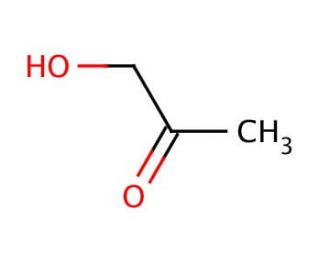

Hydroxyacetone (CAS 116-09-6)
Veja citações de produtos (1)
LINKS RÁPIDOS
A hidroxiacetona foi utilizada para estudar a oxidação aeróbica de glicerol e propanodiol sobre nanopartículas de ouro suportadas em óxido metálico em metanol. É importante para o fabrico de polióis, acroleína, corantes e agentes de bronzeamento da pele. Sofre uma redução assimétrica para produzir (R)-1,2-propanodiol na presença de um catalisador de células microbianas. A hidroxiacetona (HA) é um composto químico natural presente em várias plantas e animais, incluindo os seres humanos. Esta molécula de três carbonos tem um grupo hidroxilo ligado a um dos seus átomos de carbono. Desempenha um papel fundamental como intermediário essencial em numerosas vias bioquímicas, contribuindo para a produção de energia, aminoácidos e várias outras moléculas. As aplicações de investigação científica da hidroxiacetona são diversas e abundantes. A sua utilização abrange múltiplas áreas, desde a elucidação dos mecanismos enzimáticos até à exploração da bioquímica das vias metabólicas. Além disso, a importância da hidroxiacetona estende-se ao estudo da estrutura e função das proteínas. Além disso, tem sido utilizada na síntese de outros compostos, como os aminoácidos, e tem contribuído para avanços no desenvolvimento de novos materiais. Embora o mecanismo exato de ação da hidroxiacetona permaneça algo elusivo, acredita-se que funcione como uma coenzima, facilitando a catálise enzimática. O seu envolvimento na síntese de energia, aminoácidos e outras moléculas vitais é evidente, juntamente com o seu papel na produção e regulação de hormonas como a adrenalina e o cortisol, bem como no metabolismo dos ácidos gordos. A natureza versátil da hidroxiacetona continua a intrigar os investigadores, sendo promissora para potenciais descobertas em vários domínios científicos.
Hydroxyacetone (CAS 116-09-6) Referencias
- Análise vibracional da hidroxiacetona. | Mohacek-Grosev, V. 2005. Spectrochim Acta A Mol Biomol Spectrosc. 61: 477-84. PMID: 15582815
- Origens bioquímicas do lactaldeído e da hidroxiacetona em Methanocaldococcus jannaschii. | White, RH. 2008. Biochemistry. 47: 5037-46. PMID: 18363381
- Medição de hidroxiacetona, glicolaldeído e formaldeído atmosféricos. | Zhou, X., et al. 2009. Environ Sci Technol. 43: 2753-9. PMID: 19475945
- Agregação de hidroxiacetona que altera a conformação: um estudo combinado de FTIR, jato e cristalografia a baixa temperatura. | Sharma, A., et al. 2011. J Am Chem Soc. 133: 20194-207. PMID: 21961479
- Reacções de transferência de protões entre o ácido nítrico e a acetona, a hidroxiacetona, o acetaldeído e o benzaldeído na fase sólida. | Lasne, J., et al. 2012. Phys Chem Chem Phys. 14: 15715-21. PMID: 23090634
- Redução assimétrica de hidroxiacetona a (R)-1,2-propanodiol por Ralstonia eutropha transformante que exprime álcool desidrogenase de Kluyveromyces lactis. | Oda, T., et al. 2013. Microb Cell Fact. 12: 2. PMID: 23305396
- Produção de hidroxiacetona a partir de intermediários C3 Criegee. | Taatjes, CA., et al. 2017. J Phys Chem A. 121: 16-23. PMID: 28001404
- Hidroxiacetona: A Glycerol-Based Platform for Electrocatalytic Hydrogenation and Hydrodeoxygenation Processes. | Sauter, W., et al. 2017. ChemSusChem. 10: 3105-3110. PMID: 28643864
- A produção de formaldeído e hidroxiacetona na fotooxidação da metacroleína: Novos conhecimentos sobre o mecanismo e os efeitos do vapor de água. | Xing, Y., et al. 2018. J Environ Sci (China). 66: 1-11. PMID: 29628075
- Conversão selectiva de celulose em hidroxiacetona e 1-hidroxi-2-butanona com catalisadores bimetálicos Sn-Ni. | Wang, H., et al. 2019. ChemSusChem. 12: 2154-2160. PMID: 30767387
- Reação Organocatalítica Assimétrica de Aldol de Arilglioxais e Hidroxiacetona: Síntese Enantioselectiva de 2,3-Dihidroxi-1,4-dionas. | Zhou, YH., et al. 2020. Molecules. 25: PMID: 32028657
- Estudo cinético, dependente da temperatura, da reação de radicais hidroxilo com hidroxiacetona. | Bedjanian, Y. 2020. J Phys Chem A. 124: 2863-2870. PMID: 32172569
- Formação e investigação fotoquímica de carbono castanho por reacções de hidroxiacetona com glicina e sulfato de amónio. | Gao, Y. and Zhang, Y. 2018. RSC Adv. 8: 20719-20725. PMID: 35542337
Informacoes sobre ordens
| Nome do Produto | Numero de Catalogo | UNID | Preco | Qde | FAVORITOS | |
Hydroxyacetone, 5 g | sc-224018 | 5 g | $42.00 | |||
Hydroxyacetone, 100 g | sc-224018A | 100 g | $47.00 |
